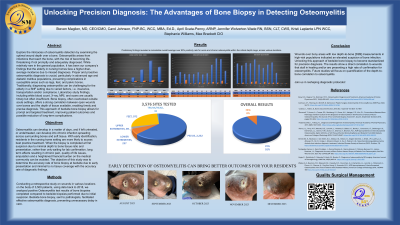Clinical Research
(CR-036) Unlocking Precision Diagnosis: The Advantages of Bone Biopsy in Detecting Osteomyelitis
Thursday, May 16, 2024
7:30 PM - 8:30 PM East Coast USA Time

Steven Magilen, MD, CEO, CMO; Carol Johnson, FNP-BC, WCC, MBA, Ed.D; April Scata-Penny, ARNP; Jennifer Wolverton-Wade, BSN, CLT, CWS; Kristi Garza-Laplante, LPN, WCC; Stephanie Williams, AS STUDENT; Max Brackett, CIO
Introduction: Explore the intricacies of osteomyelitis detection by examining the optimal wound depth over a bone. Osteomyelitis arises from infections that reach the bone, with the risk of becoming life-threatening if not promptly and adequately diagnosed. While relatively rare in the general population, the elderly in nursing homes face a higher-than-average incidence due to missed diagnoses. Proper and proactive osteomyelitis diagnosis is crucial, particularly in advanced age and diabetic mellitus populations, preventing complications in susceptible areas such as legs, feet and pelvic bones.
Methods: Conducting a retrospective study on wounds in various locations over several years, we analyzed test results confirming osteomyelitis diagnoses. Wounds over bony areas with low depth to bone measurements in high-risk populations indicated a high suspicion of bone infection. Bedside bone biopsy, sent to pathologists, facilitated effective osteomyelitis diagnosis, preventing unnecessary delay in care.
Results: Preliminary findings revealed a remarkable overall average of 97% positivity rate for acute and chronic osteomyelitis within the critical depth range, across various locations.
Discussion: Our innovative approach suggests a closer examination of wounds that stall in the healing cascade, presenting high clinical suspicion in the clinical workup. A proposed solution includes bone biopsy or MRI without contrast, especially challenging for high-risk populations. We're dedicated to unlocking precision diagnosis by offering bone biopsy beyond acute settings, addressing delays in care. Join us in reshaping diagnostic protocols and enhancing patient care by averting inadequate diagnoses and unnecessary delays in treatment.
Methods: Conducting a retrospective study on wounds in various locations over several years, we analyzed test results confirming osteomyelitis diagnoses. Wounds over bony areas with low depth to bone measurements in high-risk populations indicated a high suspicion of bone infection. Bedside bone biopsy, sent to pathologists, facilitated effective osteomyelitis diagnosis, preventing unnecessary delay in care.
Results: Preliminary findings revealed a remarkable overall average of 97% positivity rate for acute and chronic osteomyelitis within the critical depth range, across various locations.
Discussion: Our innovative approach suggests a closer examination of wounds that stall in the healing cascade, presenting high clinical suspicion in the clinical workup. A proposed solution includes bone biopsy or MRI without contrast, especially challenging for high-risk populations. We're dedicated to unlocking precision diagnosis by offering bone biopsy beyond acute settings, addressing delays in care. Join us in reshaping diagnostic protocols and enhancing patient care by averting inadequate diagnoses and unnecessary delays in treatment.

.jpeg)